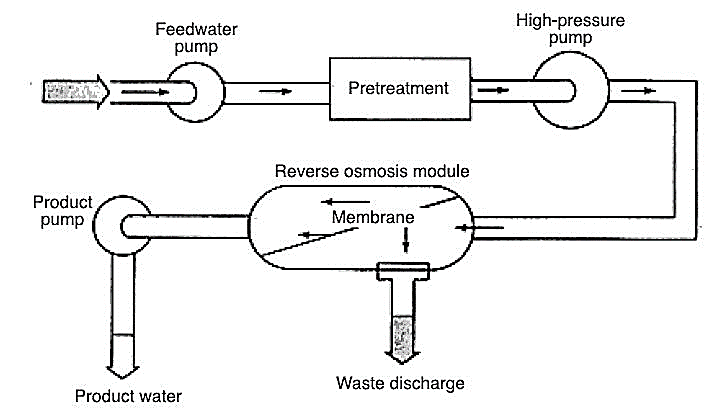
Seawater Desalination with Reverse Osmosis Plant
All Reverse Osmosis plants are mainly Desalination Plants but desalination is staying referred to sea h2o Typically.As sea drinking water has pretty large TDS involves very higher strain to pressure sea h2o through membranes that happen to be distinctive then brackish h2o membranes.
Reverse Osmosis Plant Details:
A reverse osmosis plant is actually a production plant, the place drinking water is purified and desalinated by forcing drinking water by way of a membrane, generally often known as a reverse osmosis system. H2o made by plant RO can be employed for various uses like desalination, wastewater cure, as well as reclamation of dissolved minerals.
RO Plant Description
A mean consuming water RO plant method demands 6 KW hrs of electrical power to desalinate one particular cubic meter of water. Reverse osmosis h2o vegetation needs many different pre-therapy techniques together with softening, DE chlorination, and anti-scale cure. Adhering to pre-therapy, large amounts of pressure send h2o through a semi-permeable membrane, which retains all contaminants besides water.
RO Plant Structure
To reinforce the efficiency and life of the Reverse Osmosis plant, efficient pretreatment of your feed water is necessary. Collection of the right pretreatment will optimize performance and membrane lifestyle by reducing:
Fouling
Scaling
Membrane Degradation
RO plant style and design is consisting of:
Analyzing pretreatment prerequisite of Reverse Osmosis Plant
When the feed drinking water has traces of heavy metals, it is extremely proposed to dose some chlorine to change the dissolved weighty metals to Actual physical form, the media filter will filter the vast majority of it in a ro water purifier plant.
Reverse Osmosis Plant Number of membrane
Membrane elements are a very important A part of RO vegetation. The proteins (generally polyamide) that make-up membrane features differ with regards to the ending clarity and ingestion h2o seawater or brackish h2o etcetera
Waterman engineers Australia RO plant for seawater desalination
Waterman Engineers in Australia has developed a Reverse Osmosis (RO) plant for seawater desalination, which gives many strengths about other desalination solutions. Below are a few key benefits of their RO plant:
Energy Performance:
In comparison to other desalination methods like thermal distillation, RO involves a lot less Electricity. Waterman Engineers' RO plant utilizes Superior membrane technology, allowing it to work at decreased pressures and lower Total Electricity usage.
Environmental Impression:
RO generates fewer brine discharge as compared to thermal procedures, minimizing the impact on maritime ecosystems. This aligns with Australia's give attention to environmental sustainability and conservation.
Large Water Purity:
The RO method effectively gets rid of salts, minerals, and impurities, manufacturing higher-high-quality freshwater that meets stringent consuming water requirements. This reliability is important for providing Risk-free and clear h2o to communities.
Modular Design and style:
Waterman Engineers' RO plant employs a modular layout, enabling for scalability and adaptability. This is particularly advantageous for parts with different water needs, as modules is often added or adjusted appropriately.
Lessened Footprint:
RO plants typically Use a smaller physical footprint when compared with thermal desalination crops, which frequently require substantial infrastructure for heating and cooling processes.
Swift Start out-Up and Shutdown:
RO crops is usually started and stopped fairly swiftly, making it possible for for superior responsiveness to switching h2o calls for and emergencies.
Decreased Chemical Utilization:
Not like Several other desalination procedures, RO involves less chemical substances for operation and cleansing, reducing chemical-relevant environmental considerations.
Consistency in Overall performance:
The RO process is less delicate to feedwater good quality fluctuations than other approaches, ensuring a far more regular functionality with time.
Price-Success:
When First financial commitment charges may be sizeable, RO vegetation are likely to own reduce operational and servicing fees Ultimately when compared with thermal techniques.
Reverse Osmosis (RO) is often a water purification approach that utilizes a partially permeable membrane to eliminate ions, unwanted molecules, and larger particles from ingesting water. By implementing pressure to overcome osmotic force, it enables the passage of drinking water molecules when rejecting contaminants, thereby generating cleanse h2o on 1 aspect with the membrane and concentrated impurities on one other.
The Functioning basic principle of the Reverse Osmosis (RO) plant entails applying strain to your saline Alternative to drive water molecules by way of a semi-permeable membrane. This membrane makes it possible for only drinking water to move though rejecting salts, contaminants, and impurities, causing purified h2o over the permeate facet and a concentrated Answer of contaminants within the brine side.
The advantages of Reverse Osmosis consist of generating large-top quality, clear water by getting rid of contaminants, becoming efficient and value-efficient with time, necessitating nominal chemical use, and currently being adaptable to numerous scales of Procedure from smaller home systems to significant municipal vegetation.
RO plants have changed Demineralisation (DM) vegetation since they often offer a a lot more efficient and price-successful Answer for h2o purification. RO techniques don't have to have the regeneration chemical substances that resin-centered DM vegetation do and will take away a Desalination Plant Manufacturer broader range of contaminants, which include dissolved solids and microorganisms.
Waterman Engineers Australia probably takes advantage of Reverse Osmosis (RO) plants for seawater desalination by forcing seawater by way of a semi-permeable membrane to get rid of salt as well as other impurities. This process provides new, potable drinking water from the ocean, addressing water scarcity and giving a sustainable supply for a variety of requires.